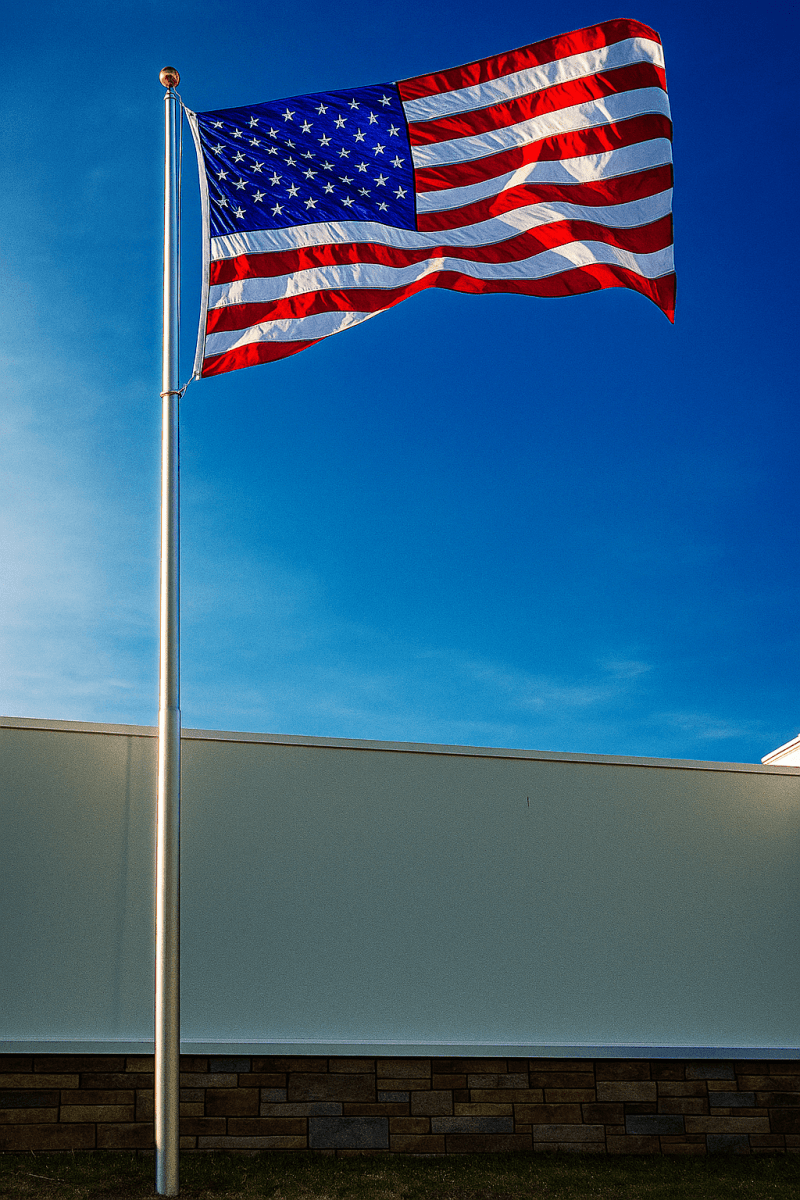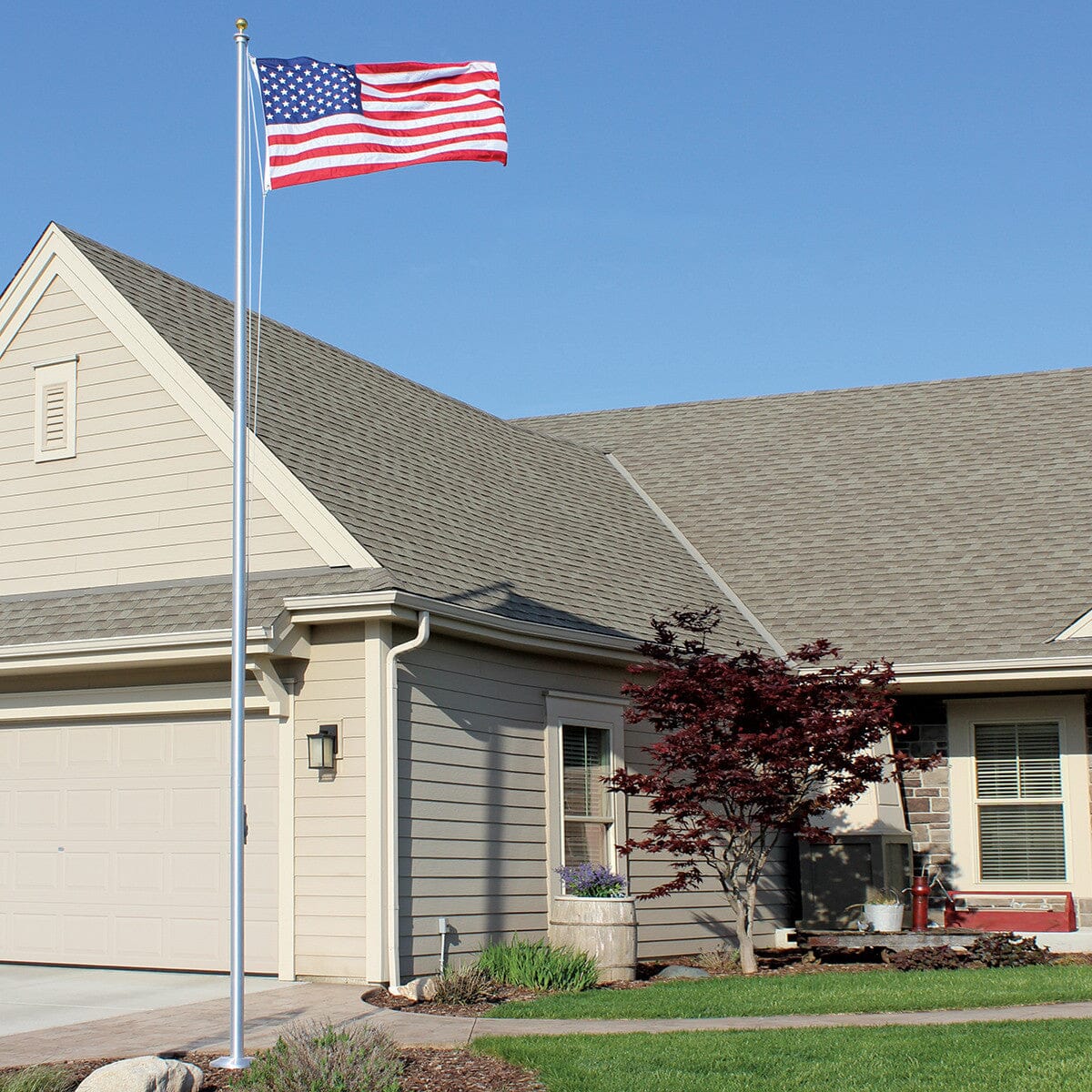A flagpole is a symbol of pride, patriotism, and service. Whether you’re a homeowner or business owner, it’s necessary to know which features to look for in a high-quality flagpole kit. This guide breaks down what matters most—materials, mounting, wind ratings, and hardware—so you can invest with confidence.
Material Matters: Strength, Durability, and Weather Resistance
The material you choose directly affects the flagpole’s strength and longevity. Aluminum offers a great balance of durability and rust resistance. Steel provides extra strength for high-wind or commercial areas, but it needs protective coatings to prevent rust. Fiberglass bends under pressure instead of breaking, handling extreme weather well, but it commonly comes with high costs.
No matter the material, choose poles with powder-coated or anodized finishes. These treatments fight corrosion and keep your flagpole looking sharp for years.
Height and Sections: Picking the Right Size for Your Space
Check Local Regulations
Before choosing your height, check local ordinances and homeowner association rules. Many communities impose height restrictions, particularly in residential areas. Some neighborhoods require permits for flagpoles exceeding specific heights.
Choose a Flagpole Height That Complements the Space
Selecting the appropriate height requires you to think about visibility, aesthetics, and local regulations. Residential flagpoles typically range from 15 to 25 feet. This provides excellent visibility without overwhelming the property’s proportions. Commercial installations typically rise between 30 and 60 feet to achieve ample visibility from great distances.
Sectional Flagpoles Offer Advantages
The pole’s design significantly impacts both installation and performance. A sectional flagpole kit offers numerous advantages over single-piece alternatives. These multi-section poles ship more easily, cost less to transport, and provide better structural integrity when properly assembled. Quality sectional designs use internal sleeves or external coupling systems. They create seamless joints stronger than single-piece construction.
Fewer Sections Mean Better Performance
Flagpoles come in sections. The fewer sections there are, the stronger the flagpole will be.
A three-section pole costs more than a five-section pole. The reduced number of joints creates superior strength. The composition also eliminates potential weak points that could fail under stress.

Telescoping vs. Traditional Flagpoles
Flagpoles come in two main types: telescoping and traditional rope-and-pulley systems.
Telescoping flagpoles extend and retract like an antenna, letting you lower the entire pole for easy flag changes and maintenance—no ladder needed. They’re a popular choice for homeowners who want convenience and safety.
Traditional flagpoles use halyard systems with ropes, pulleys, and cleats. While they require more skill to operate, they accommodate large flags better and allow multiple flags on one pole. These are common in commercial settings for their durability and performance.
Choose based on your needs: telescoping poles suit residential use and standard flags, while traditional systems are best for larger flags or demanding conditions.
Halyard Systems: Internal vs. External
Your halyard system controls how you raise and lower the flag. Internal halyard systems run the rope inside the pole, offering a clean look and added security. Many commercial and high-security settings will use an internal halyard system.
External halyards place the rope and hardware on the outside. They’re easier to maintain and more affordable, making them a popular choice for homeowners.
No matter the design, look for halyard systems with secure cleats, locking mechanisms, and corrosion-resistant stainless-steel hardware. Quality components facilitate smooth operation and protect against wear, weather, and unauthorized access.
Mounting and Base Options
A sturdy flagpole foundation that complements the environment will be stable and long lasting. Three main mounting styles handle different installation needs: ground-set, wall-mounted, and shoe base systems.
Ground-Set Installation
Install ground-set poles by digging a hole and setting the pole in concrete. This permanent method provides maximum stability for large poles and high wind. However, it requires ample preparation. Also, keep in mind that you can’t easily relocate the flagpole after installing it.
Wall-Mounted Brackets
Wall-mounted brackets attach flagpoles to buildings or other structures. These work well for shorter poles and offer good stability when you install them correctly on solid surfaces. Wall mounts give you more flexibility than ground-set options, but they limit pole height and flag size.
Shoe Base Systems
Shoe base systems use above-ground brackets that bolt to concrete pads or existing surfaces. These allow easier relocation and require less digging, but they may limit wind load capacity compared to ground-set options.
Consider your installation site, local wind, and future flexibility when choosing your mounting. Quality manufacturers provide engineering specs and wind load ratings for each mounting style.

Flagpole Hardware: Don’t Overlook the Accessories
Quality hardware is just as important as the flagpole itself. The components support smooth operation and offer strength against the elements.
Core Components That Matter
A complete flagpole kit should include a finial (often a gold ball) for style and protection, along with a truck and pulley system that operates smoothly in all weather. Look for stainless steel parts and sealed bearings to prevent corrosion and ensure reliability.
Snaps, clips, and cleats directly affect how securely your flag flies. Stainless steel snaps protect your flag’s grommets, while solidly mounted cleats keep the halyard locked in place during high winds.
At the base, a flash collar helps keep water out of the foundation, and a properly sized ground sleeve or mounting bracket ensures a stable, long-lasting installation.
Why Cheap Hardware Costs More in the Long Run
Avoid kits with flimsy or plastic parts. They fail quickly and often require early replacement. Investing in high-quality hardware means fewer headaches, better performance, and a flag display that continues to look sharp for years.
Wind Ratings and Engineering
Not all flagpoles can withstand the same weather conditions. Understanding wind ratings and engineering specifications helps you choose equipment appropriate for your location’s climate conditions.
Wind speed ratings indicate the maximum sustained wind velocity a flagpole can handle safely. Most residential areas require poles rated for 70 to 90 mph winds, while commercial installations or locations with severe weather may need ratings of 100 mph or higher.
Engineering specifications detail the mathematical calculations that determine a pole’s wind load capacity. These calculations consider pole height, diameter, wall thickness, material properties, and mounting method. Reputable manufacturers provide detailed engineering data and may offer custom calculations for unusual installations.
Reading wind charts helps you understand how different combinations of pole height, flag size, and wind speed affect structural loads. Large flags create more wind resistance and require stronger poles or reduced height limits. Understanding these relationships helps you optimize your flagpole selection for both performance and safety.
Invest in a Flagpole That Honors Your Values
When choosing a flagpole, focus on the features to look for in a high-quality flagpole kit: durable materials, solid engineering, and reliable hardware. Investing in quality gear ensures your display stays dignified and dependable.
Take time to compare specs, verify components, and choose a trusted supplier. The right flagpole kit won’t just raise your flag; it will honor everything it represents.







